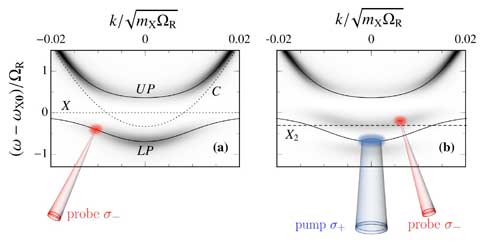| Apr 27, 2020 | |
Applying quantum-impurity theory to quantum fluids of light(Nanowerk News) A Monash-led study develops a new approach to directly observe correlated, many-body states in an exciton-polariton system that go beyond classical theories (Physical Review Letters, "Spectroscopic signatures of quantum many-body correlations in polaritons microcavities"). |
|
| The study expands the use of quantum impurity theory, currently of significant interest to the cold-atom physics community, and will trigger future experiments demonstrating many-body quantum correlations of microcavity polaritons. | |
 |
|
| Spectroscopic signature of two-point, many-body correlated state. Left: In absence of pumping. Right: With pumping. (Image: Monash University) (click on image to enlarge) | |
Exploring quantum fluids |
|
| “Exciton-polaritons provide a playground in which one can explore room temperature quantum fluids, and the novel properties of many-body non-equilibrium systems,” says study author A/Prof Meera Parish. | |
| However, despite their intrinsic quantum nature as superpositions of matter and light, most recent results can be described through the physics of non-linear, classical waves. | |
| The new study shows how one can probe beyond mean-field quantum correlations in a many-body polariton system through quantum impurity physics, where a mobile impurity is dressed by excitations of a quantum-mechanical medium, thus forming a new polaronic quasiparticle that defies a mean-field description. | |
| “Observing beyond mean-field quantum correlated behaviour with polaritons is an important milestone toward using polaritons for quantum technologies,” explains lead author Dr Jesper Levinsen, who is an ARC Future Fellow and collaborator of A/Prof Parish in Monash University’s School of Physics and Astronomy. | |
| At the few-particle level, there has recently been progress in achieving weak anti-bunching and polariton blockade in a fibre cavity, where confinement of photons enhances non-linearities. | |
| Similarly, complex multi-dimensional spectroscopy has been used to study quantum correlations. However, experiments demonstrating beyond mean-field quantum correlated behaviour at the many-body level still remain elusive. | |
| The study provides an alternative route to explore such correlations, making use of pump-probe spectroscopy methods, which have already been demonstrated by experiments. | |
| “Our findings match the results of these experiments, but show that experiments have so far missed the regime where multi-point quantum correlations can be seen,” says Dr Levinsen. |
| Source: ARC Centre of Excellence in Future Low-Energy Electronics Technologies | |
|
Subscribe to a free copy of one of our daily Nanowerk Newsletter Email Digests with a compilation of all of the day's news. |
